|
March 2000
Labradors
|
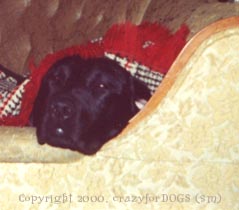
Dawg at Home
|
Growing up, my family usually included a bouncy, lively black Labrador Retriever. I don’t remember the first Lab, Yorick, because I was just a toddler, but my mother told me how he was so good around me and very protective. I guess he thought of me as his little sister-pup because he wouldn’t let any strangers near me.
Later, when I was 10, I came home from school one day and found a big, tail wagging, jumping Labrador that my father had brought home. This Lab would only answer to the name "Dog" (which we made slightly less generic by spelling it "Dawg") because he had already had two other owners and had spent time in the pound in between.
Dawg quickly made himself at home. He slept on the beds, sat on the sofa, begged at the table, and generally got into everything. At first, my parents would put him in the garage when no one was home. Dawg did not like being left alone, however, and would eat non-edible things to express his displeasure. In those days my father owned an off-road motorcycle. One day he came home to find the seat shredded and in bits on the floor (and probably some in Dawg’s stomach, too). Dawg ate some steel wool he found in the garage one day. It soon became apparent that Dawg either had to be allowed in the house where he would at least just snooze on the sofa or he had to be taken along. Dawg liked this arrangement just fine – especially being taken along. Like most dogs, he loved riding in the car with his head out the window, snorting into the wind.
Unlike most male Labradors, that stand between 22 ˝ – 24 ˝ inches
at the withers and weigh between 65 - 80 pounds (females: 21 ˝ - 23 ˝
inches and 55 to 70 pounds), Dawg was probably closer to 25 or 26
inches and weighed over 100 pounds. In his youth, he was all muscle,
too. When my father would get his motorcycle out of the garage, Dawg
would get excited and start barking.
| As soon as my father started
off, Dawg would run after him. My father often rode a circuit near
our house, and Dawg would begin by following close behind. After a
while, Dawg lagged a little behind. Then further behind. Then my
father would start lapping him. Dawg would just be trotting, his
tongue hanging down to his knees (almost!), but he wouldn’t quit
until my father put the motorcycle away. Then Dawg would lap up a
long drink and sack out for awhile. The next time he was ready for
another round. If he weren’t allowed to participate in this fun
pastime, he would flop down on the floor inside, head on his paws,
looking morose. |
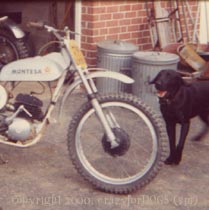
Let's Go!
|
Being a typical Labrador, Dawg loved the water. We lived near an area with a small pond. In January, Dawg liked nothing better than a swim in the cold water. Or at any time of the year. Labradors have short, dense, weather resistant coats that shed water quickly and protect them from the environment.
Dawg also liked to run off when he wasn’t watched closely. On many occasions I would have to run up the street in the neighborhood after a gleeful Dawg. He would try to keep just out of my range, while still stopping to check out all the exciting smells. Eventually, he would find something to sniff at that was so engrossing, he wouldn’t hear me sneaking up on him. I’d grab his tail and when he swung his head around to see who it was, I’d get a hand on his collar. Then, I’d march him back home, one hand on the collar and one hand on the tail, telling him what a bad dong he was. In a un-Lab-like fashion, he would usually growl at me, annoyed that I interrupted his adventure. This would make me even madder, so he wouldn’t get his usual treat when he went inside.
Dawg loved his dog biscuits. He had to have a treat whenever he came in from outside. He would bark if he didn’t get one. Eventually, he learned the trick of barking loudly whenever someone was on the telephone until he got a treat. (This was in the days before portable phones, so we couldn’t just walk into another room.) He also, as I said, begged at the table (useful if I wanted to get rid of something on my dinner plate). He would beat the floor with his paw, drool, and then bark until he was given a treat.
Despite his demanding tendencies, he was a typical, loving and affectionate Labrador. He loved attention and to play games (fetch and tug of war were his favorites). He was always great around kids and tolerated any amount of tugging and pulling. Labradors are known for being great family dogs, and Dawg was no exception.
My family got our next Labrador Retriever, Marco, when he was a puppy. Labrador Puppies are so cute. Their faces look somewhat different from a mature Labrador’s face because their muzzles are not as long in proportion to the size of their heads. They look rather like cuddly little bears. As they mature, they outgrow the "bearish" appearance.
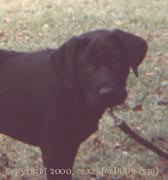
Marco Puppy
According to The Guide to Owning a Labrador Retriever, the head should be wide and well developed, but not exaggerated. There should be a moderate stop (break) where the muzzle joins the brow. The muzzle itself should be neither too long, nor too short, and it should not be snippy.
Marco had all the energy you would expect from a young puppy and
he loved to run around and get into everything. One of his favorite
places was under the sofa. But he didn’t limit himself to the sofa;
he might be in the living room one second and disappear the next,
only to be found under the dining room table. He was named after
Marco Polo because he, too, was a great explorer.
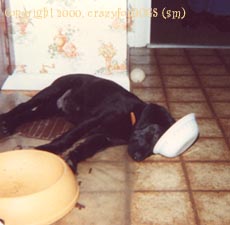
Nap Time |
Marco would also run around full-speed, then suddenly run out of
steam and collapse in a puppy heap and nap where he happened to fall.
Then, he’d hop up and zip around, ready for more adventures. |
Of course, he didn’t come housebroken, and we’d find little puddles on the floor if we weren’t careful. Routine walks and whisking him out the door when he looked like he was getting ready to go soon taught him what to do. Like all Labradors, Marco was a very intelligent dog. Marco had a more typical Labrador temperament, compared to Dawg. Marco was less aggressive and demanding, but just as full of fun, liveliness, and a desire to please.
As Marco grew older, he got too big for snooping around under the sofa, although it took him a while to realize this, and he would try to wedge himself under the sofa before giving up. He was an average size Labrador, with the usual Labrador conformation. He was sturdily build, with strong legs. He had a muscular neck, well-developed (but not exaggerated) chest, and a straight back. His tail was the usual "otter" tail, thick at the base and tapering.
| Today, my parents still have a black Labrador, this one named
Thunder. (He was a Sirius of the Week in November, 1999.) Once you
get hooked on this gentle, loving, intelligent breed, you want to
have a Labrador in your life. Labradors are one of the most popular
breeds in the United States. |
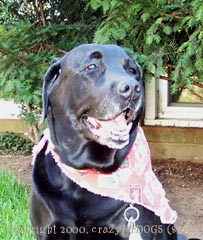
Thunder
|
Labrador Retrievers were not really known in the U.S until after World War 1. A few were imported then, but it wasn’t until the mid-1930’s that they began to attract attention. Labradors were very successful in winning field trials compared to other breeds, and the numbers of Labradors in the United States grew quickly.
Labs came to the U.S. from England. No one is exactly sure of the origin of the breed, however. Although authorities agree that Labradors descended from the St. John’s variety of water dog, various theories have been proposed for the lineage further back. One theory says Labrador Retrievers were brought to Newfoundland by fishermen from Devon. A second theory says that Labradors originated in North America. Yet another claims they are of Asiatic descent.
Whatever its origins might be, the Labrador Retriever was brought to England in the 1820’s, presumably by the Earl of Malmesbury, who devoted his entire kennel to developing and stabilizing this earlier form of Labradors. After a while, it became impossible to import any more dogs from Newfoundland into England, other types of dogs like curly-coated and flat-coated retrievers and water spaniels were occasionally bred with the Labradors. But, the breed characteristics we recognize today were established early and remained predominant.
The Kennel Club in England officially recognized the Labrador Retriever in 1903, although a definite standard of conformation had not yet been agreed upon. But the devotes of the breed were particularly interested in developing a working dog, and the breed programs worked mostly to develop the Labrador’s abilities in the field as an athletic retriever.
When I was a kid, I didn’t know that Labradors came in any other color but black, but they do. The yellow Labrador can range in shade from a cream to reddish. Chocolate Labradors can be light to dark brown. Both the black and yellow Labs have black noses. The chocolate Labs have brown noses. All three colors of Labradors have brown eyes, although chocolates can have hazel eyes. The black and yellow Labs have black eye rims, while the chocolate Labradors have brown eye rims. Other than these color distinctions, the three Labs look the same.
The Guide to Owning Labrador Retrievers, by Richard T. Burrows, T. F. H. Publications, Inc., Neptune City, New Jersey, 1997.
|



